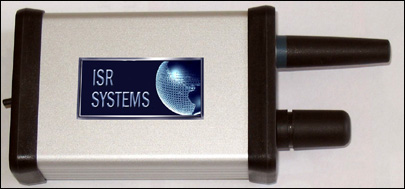ISR Systems, a company based in Newport Beach, Calif., has announced a hardware, software and services platform called Trusted Shipper. The firm says this platform will enable manufacturers and shippers to add EPC tags to cases and pallets of goods at the source of manufacture, then track them while they are in transit and monitor their security.
RFID tags are read automatically when brought through an interrogation zone, rather than with the manual scanning required for bar codes. Therefore, tagged shipments will likely be received and processed at ports, distribution centers and warehouses further down the supply chain more quickly than those with just bar code IDs (as long as those ports, distribution centers and warehouses have the RFID hardware infrastructure needed to read those EPC tags). In addition, records of receipt for tagged goods will also likely be more accurate than those received through bar code scans, since the chance of error through manual scanning will be removed.
ISR says it has developed and tested all of the individual parts of the Trusted Shipper platform and hopes to announce its first end-to-end pilot of the integrated system with an undisclosed Asian manufacturer this fall.
The Trusted Shipper system is comprised of the SupplyChain Guardian platform, which provides RFID tagging and an electronic manifest to satisfy the U.S. Department of Homeland Security’s Container Security Initiative (CSI); and the Container Guardian platform, which allows users to track individual containers using a global positioning system (GPS), and to monitor the integrity of those containers, using RFID tags integrated with sensors. While the goods are in transit and within range of a GSM cell phone network, a general packet radio service (GPRS)—a packet-based wireless communication service for GSM cell phone networks—transmits location and sensor data to RFID Controller, a Java-based software application developed by ISR Systems. Since RFID Controller is Web based, ISR Systems staff can access it from any device linked to the Internet.
In SupplyChain Guardian, RFID Controller is used to generate and assign EPCs to goods and create advance shipment notices (ASNs) for retailers or the DOD in compliance with their individual RFID mandates. It also generates the electronic manifest that U.S. Customs requires 24 hours before any container is loaded onto a vessel.
Michael Skellern, CEO of ISR Systems’ parent company, Universal Guardian, says Trusted Shipper customers begin the process by installing the RFID interrogators, printers and other RFID hardware and software necessary to tag cases and pallets of goods—including the RFID Controller application—within their overseas manufacturing facilities. When providing tagging services, ISR Systems will install Sato RFID printer-encoders and SAMSys RFID interrogators. Some manufacturers and suppliers, though, will likely prefer to maintain their own tagging operations, he says.
ISR Systems will generate an electronic manifest of all the goods once they are tagged. U.S. Customs requires this manifest 24 hours before any container is loaded onto a vessel for transport to the United States. This manifest will also be used to create an ASN, which will include the EPC data assigned to the cases and pallets of goods destined for retailers or the DOD.
To track a container’s location while it is in transit and GSM range, Container Guardian uses the T2 GPS tracker, an active RFID transponder integrated with a GPRS modem and a GPS receiver. If any of the sensors detect abnormal changes within a container while it is outside of GSM range, the T2 keeps a record of these changes and then transmits that info when the T2 is within range of a GSM network. According to David Hopps, ISR Systems vice president, the T2 is designed to function in dense environments, such as in ports or cities, where signal interference renders most GPS units inoperable. He says the T2 can also be used to track containers buried beneath as many as five other containers inside a ship—without the use of a signal repeater.
Placed inside each container being tracked, the T2 is wired to a sensor module called the S6, a conglomerate of six different sensors that track shock, temperature, humidity, smoke, light and ultrasonic frequency changes. The S6 can be configured to transmit an alert when the environment inside the container changes beyond predetermined levels, possibly due to a security breach.
RFID Controller processes the GPS and sensor data from each container transmitted by a T2 Tracker. An ID for the ASN of each container is cross-referenced with the container’s T2 Tracker ID in RFID Controller’s database of GPS and sensor data, so that the contents and location of the container are both known.
ISR has established data centers in Beijing, Hungary and Newport Beach, Calif. At these locations, staff will monitor the RFID Controller for any alerts generated by the sensors while the cargo is in transit, then route them to the shipper or manufacturer of the goods.
Container Guardian uses the S6 instead of an electronic seal to secure the container, says Skellern, because it is possible to break into a container without breaching electronic seals.
ISR Systems says it has APIs that enable RFID Controller to be integrated with enterprise software platforms from Oracle and SAP. The software has also been preconfigured to satisfy RFID mandates from Metro, Target and Wal-Mart, and the firm is currently working with Best Buy to enable the software to meet that retailer’s mandate specifications, as well.
In addition, ISR is offering services to manufacturers and shippers that will help them meet security requirements to participate in the Customs-Trade Partnership Against Terrorism (C-TPAT), a U.S. Customs and Border Protection program launched after 9/11. By participating in the C-TPAT and qualifying for its “green lane” program, these manufacturers’ shipments will receive expedited Customs processing.
ISR says it can help companies meet C-TPAT’s security requirements, including a security audit of the facilities used by manufacturers and shippers involved in the transport of goods to the United States, by using the services of Universal Guardian’s Secure Risks global security group. The Secure Risks group, which provides security services to government and military organizations worldwide, worked with the Department of Homeland Security on Operation Safe Harbor, a program that tested new security measures for cargo containers. C-TPAT and the DHS have certified the Secure Risks group to provide these security services, which includes semiannual inspections of the manufacturing and shipping facilities and the installation of security cameras at those facilities.
Skellern says that participating in C-TPAT and enabling shipments to go through the green lane turns “security compliance into financial advantage” for manufacturers and shippers, because goods in the green lane will reach their destinations sooner than those outside of it. He adds that with the Trusted Shipper system, manufacturers will receive an even stronger competitive advantage than just participating in the green lane program, because the Trusted Shipper platform enables suppliers that manufacture goods in China and other overseas locations to bring RFID tagging to the source of their manufacturing.



